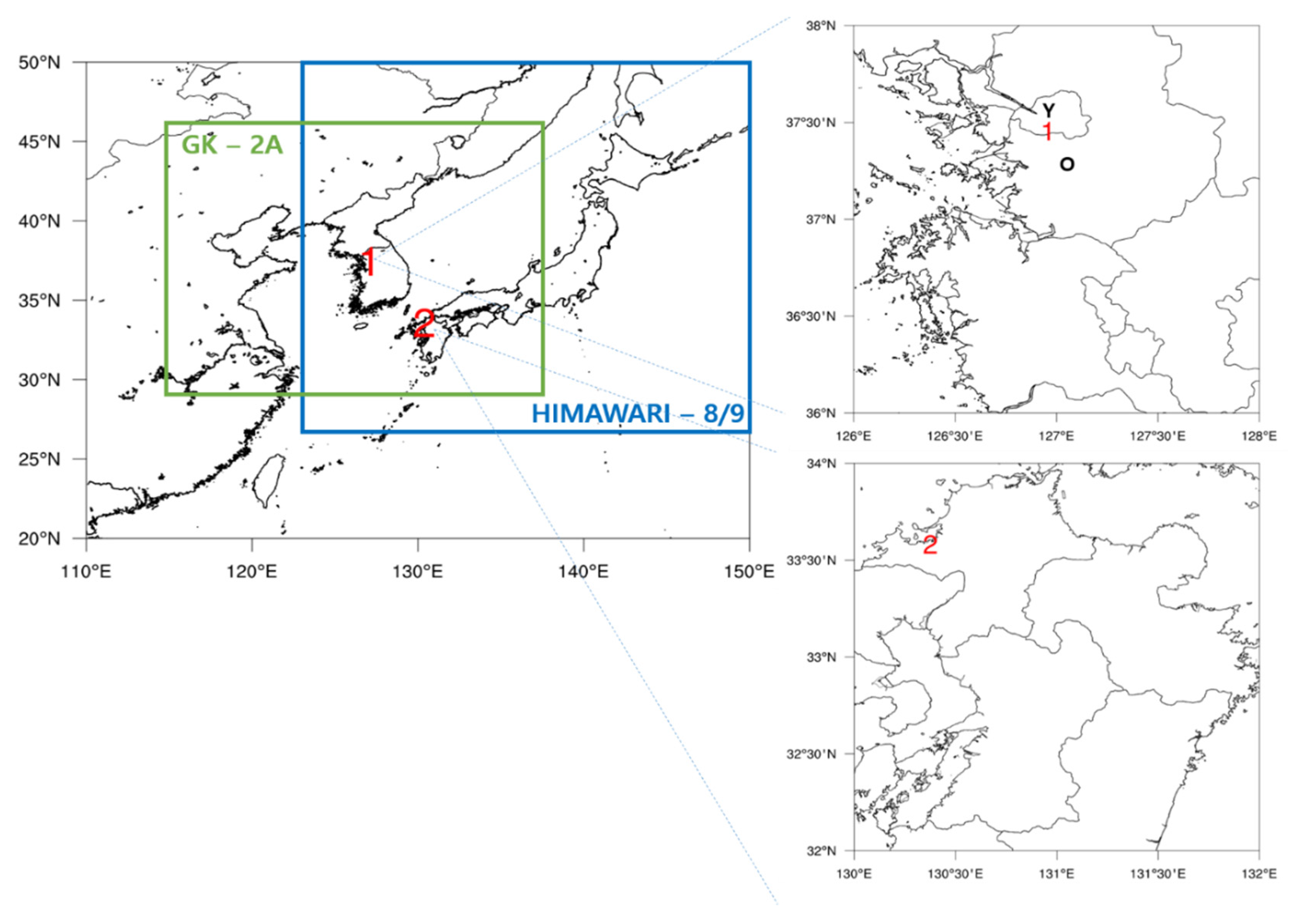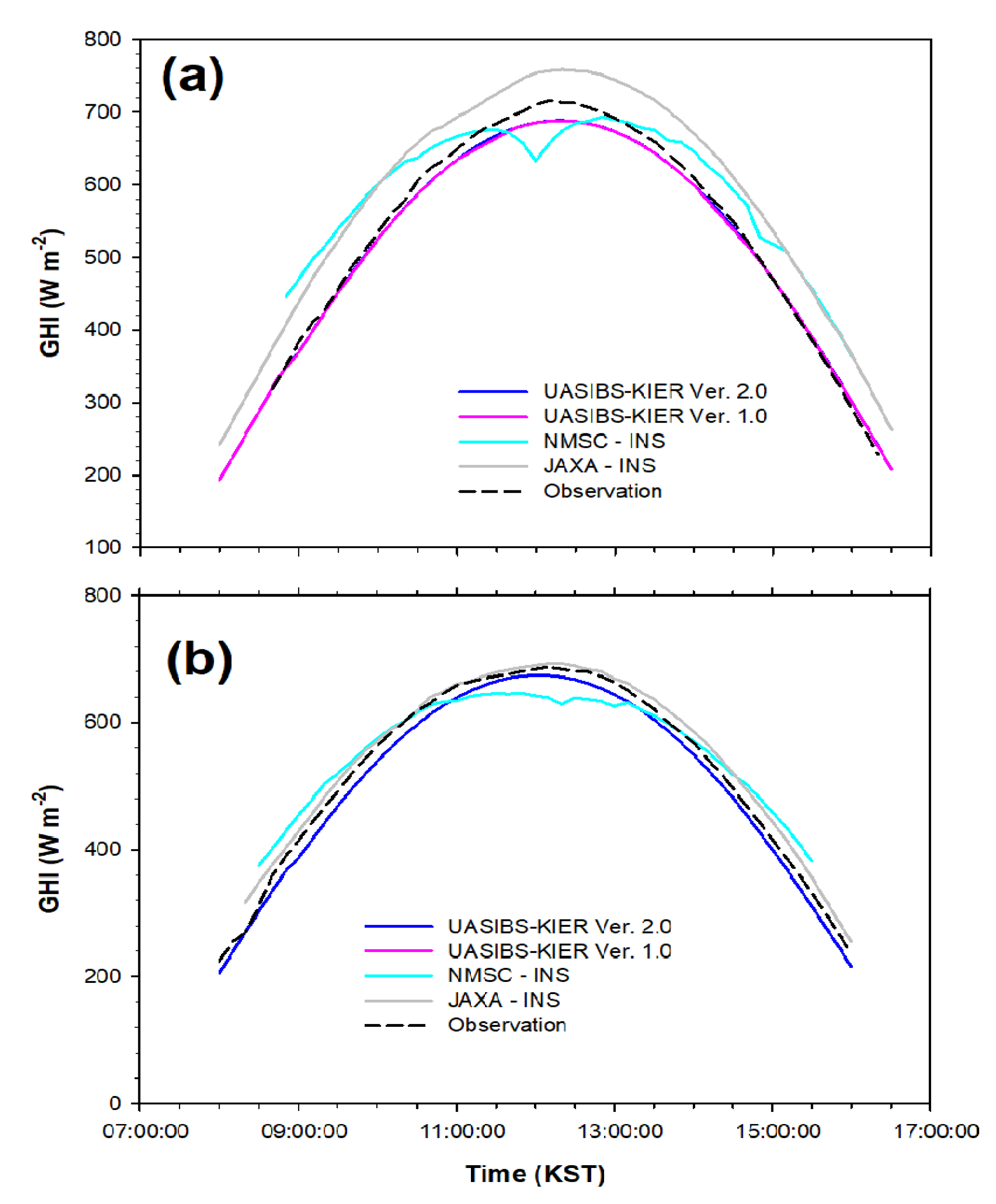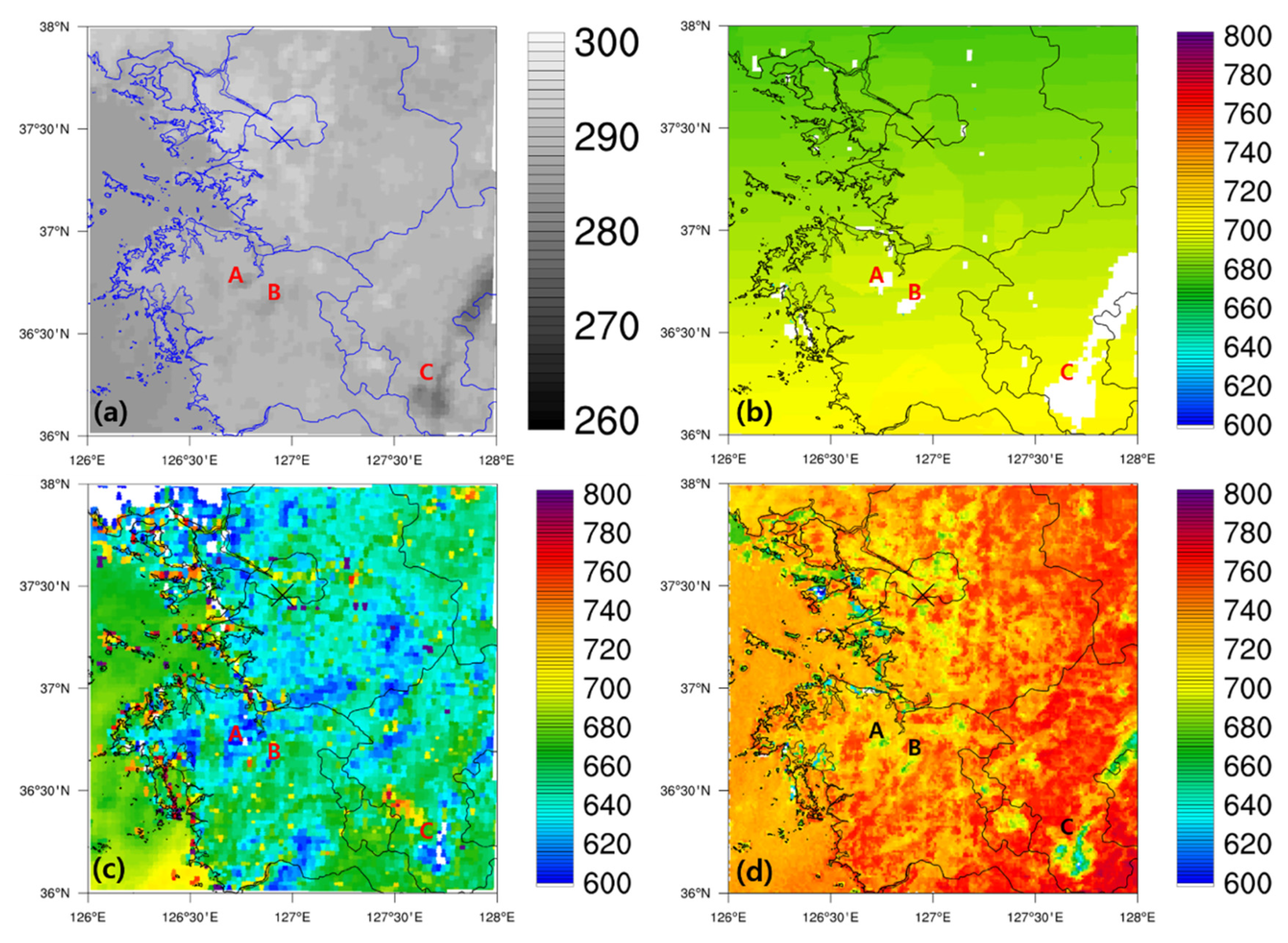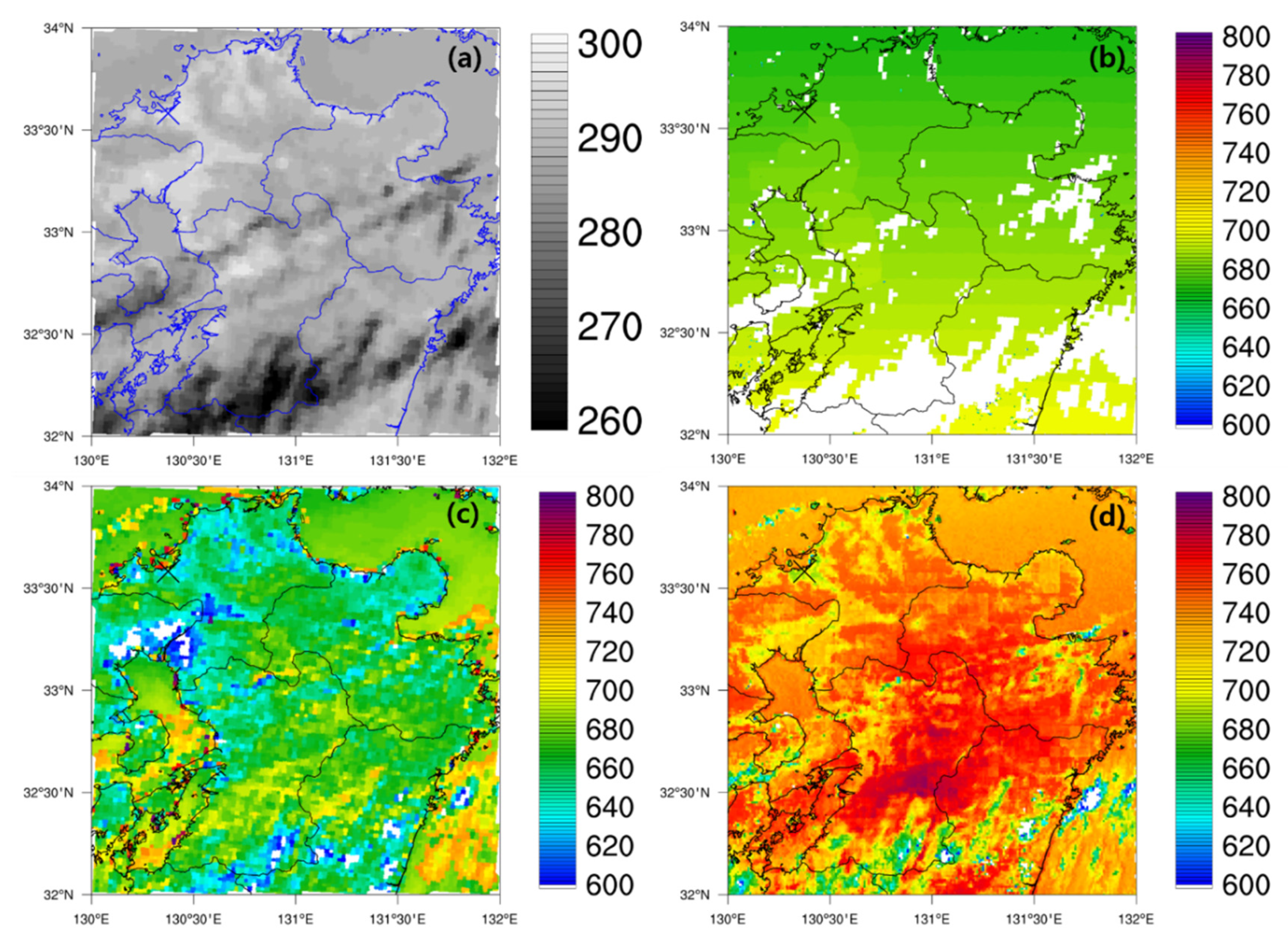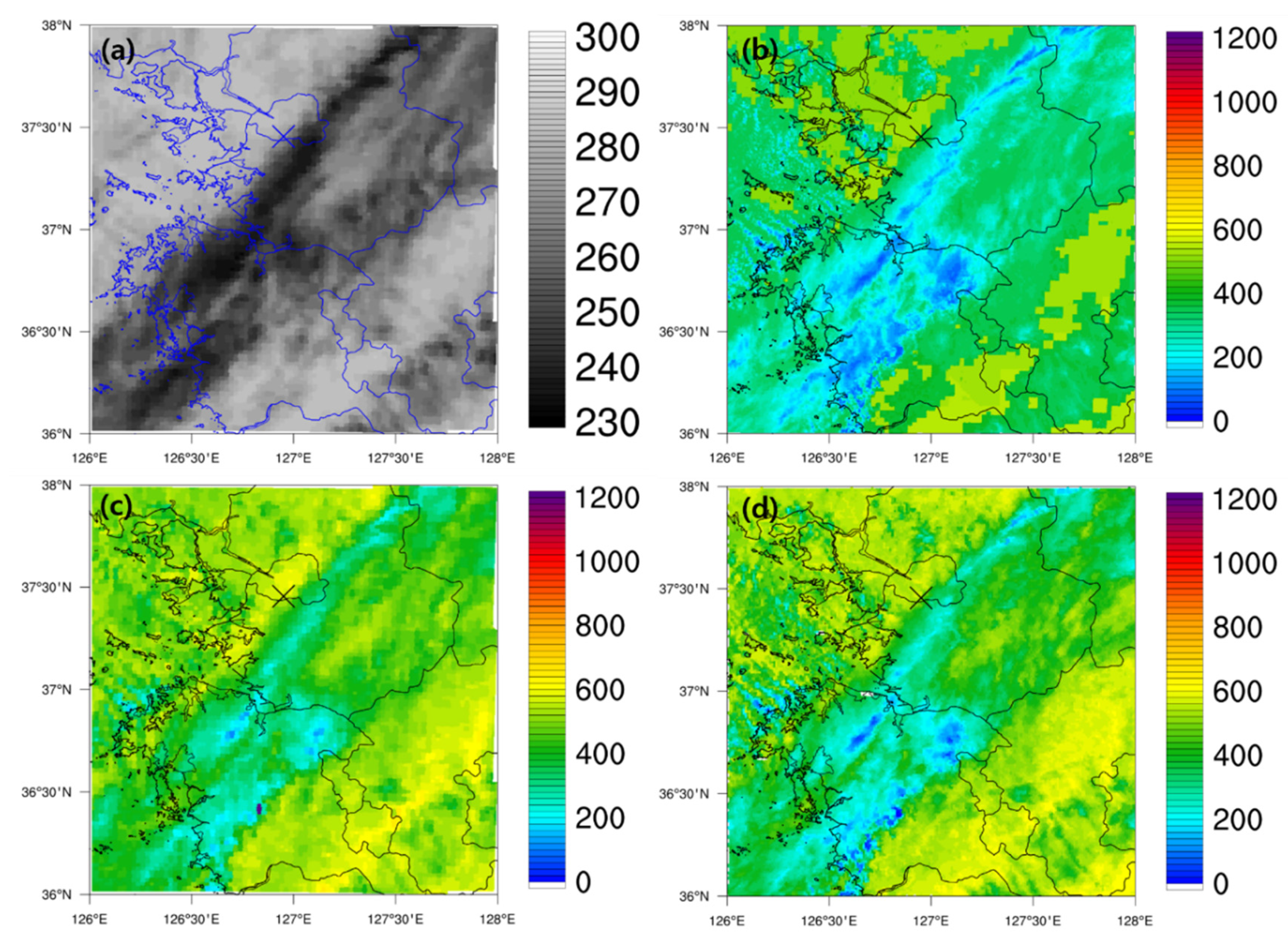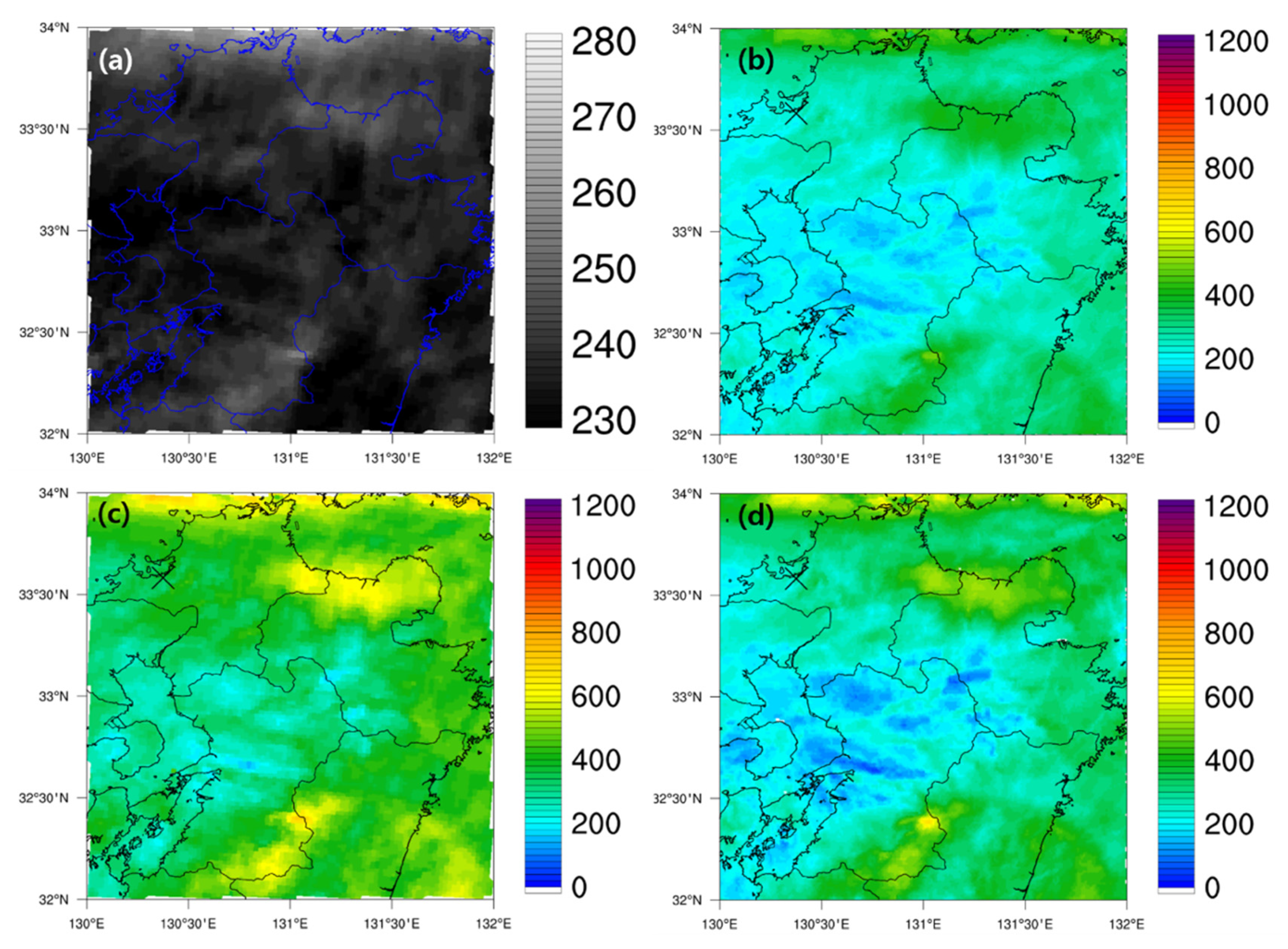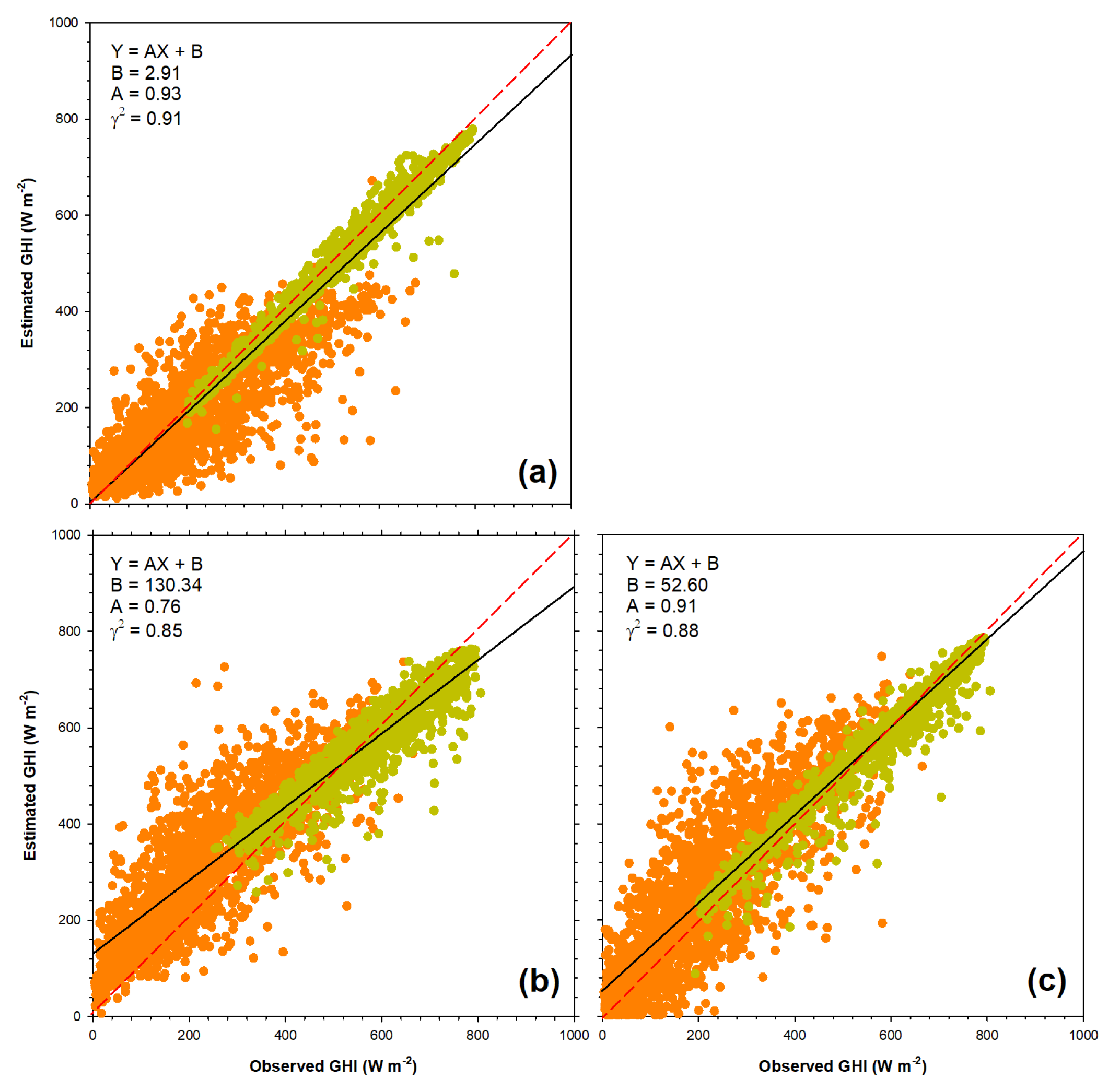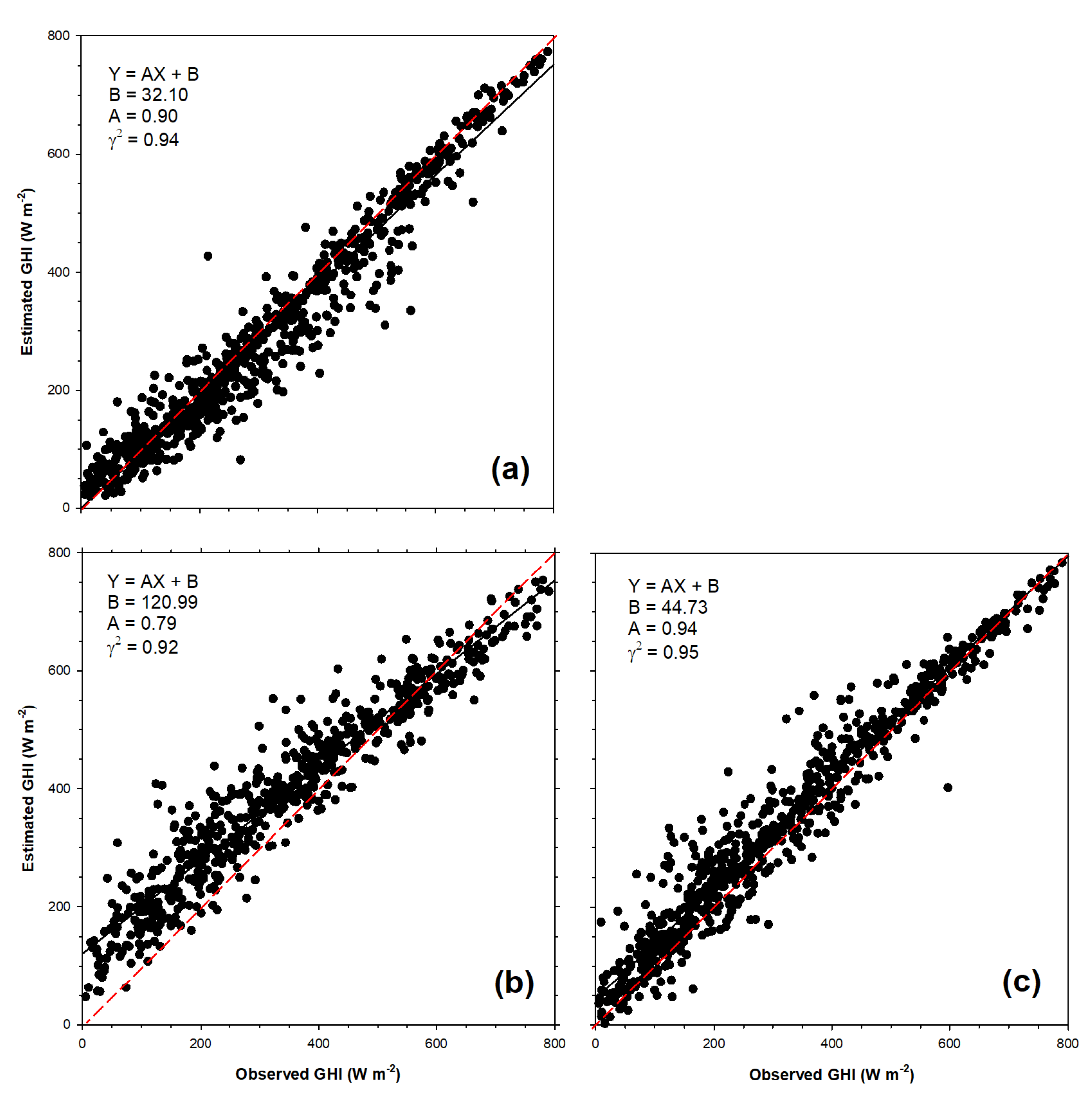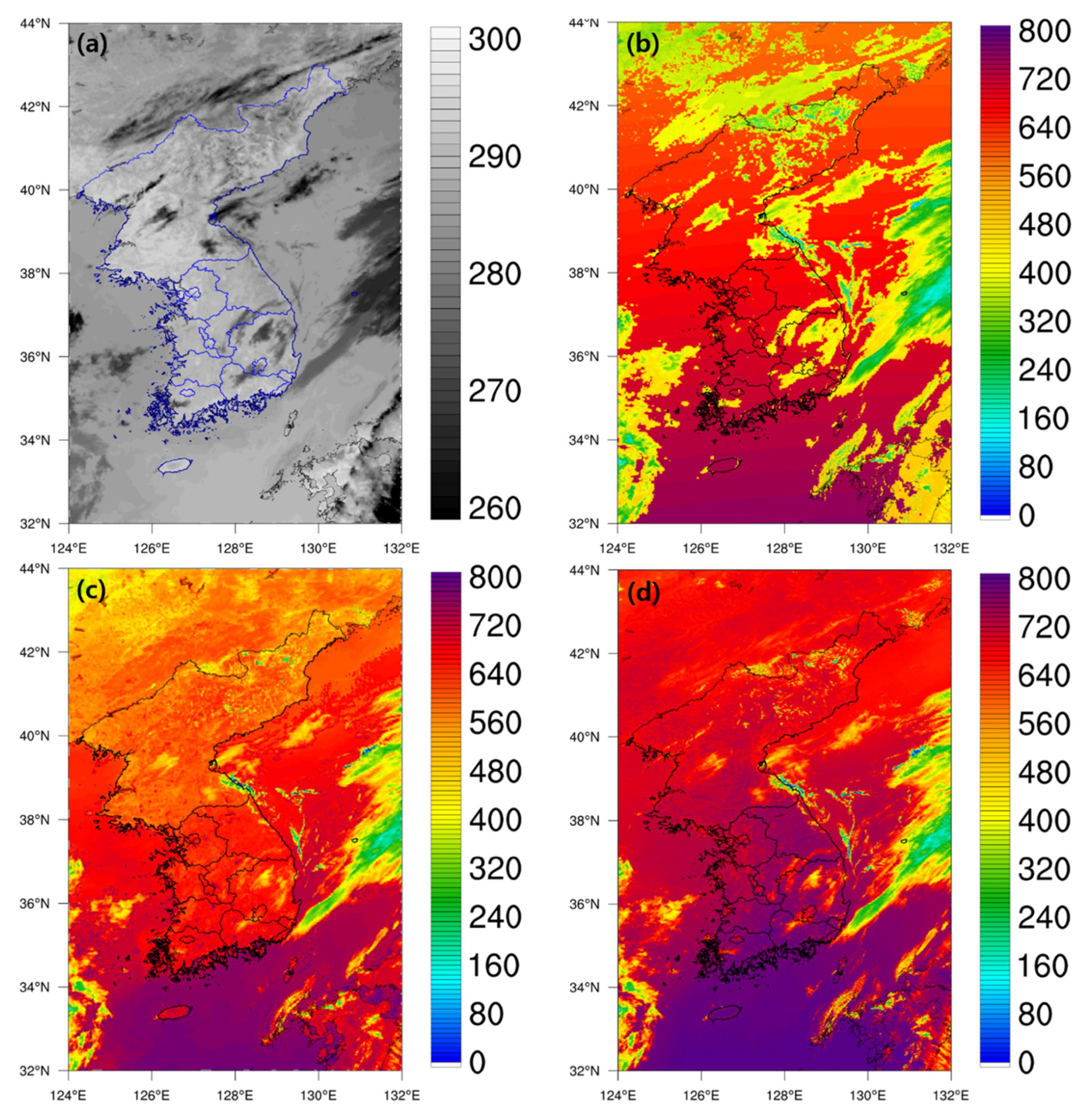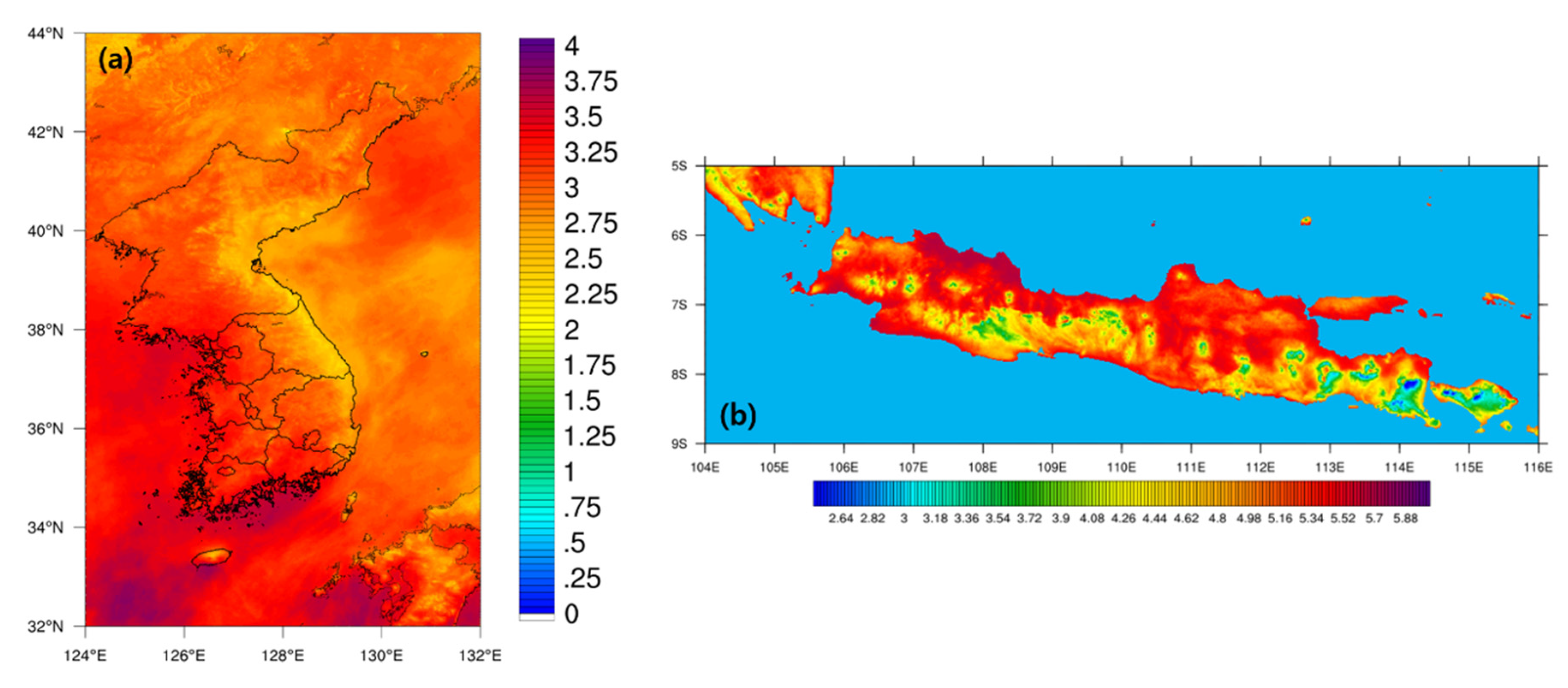5.1. Instantaneous Evaluation
DHI is sometimes much higher than GHI at an instantaneous timescale, which is referred to as overirradiance or cloud enhancement [
50,
51,
52]. This is due to the reflection of solar radiation at the edges of clouds. This study eliminates pairs of estimates and observations from the analysis when the
ktm is higher than 1.1 to avoid the overirradiance. The GHI measured by pyranometer is averaged over 10 min intervals centered on the acquisition time of the satellite imagery provided by COMS, GK-2A, HIMAWARI-8/9, for comparison with the GHI estimates, because the COMS MI sensor takes 27 min to scan the entire field of view of the target area. Previous studies [
22,
32] separately validated the instantaneous GHI estimates for clear and cloudy skies. Therefore, this study also follows the same threshold value of
ktm, as described in Kim et al. [
22]. The clear sky is determined when
ktm > 0.9, otherwise, the cloudy sky is determined.
Two examples of the instantaneous GHI estimates are provided in
Figure 2 with ground observations at the SNU and FUA stations. The behavior of GHI estimates are approximately similar between V1 and V2 of the UASIBS-KIER model. This makes sense because the look-up table for the clear sky is generated by GSFC RTM with the same ancillary data (AOD, O
3 and water vapor profiles), regardless of the UASIBS-KIER model version. The JAXA-INS model estimates that the GHI is larger than observed in the SNU station. In the study of Frouin and Murakami [
44], clear sky GHI is dependent itself on clear sky transmittance. Uncertainties of AOD appear to influence the large deviation from ground data at the SNU station. Additionally, the NMSC-INS model produces a negative bias at noon, which means that the GHI is attenuated due to the clouds. However, the infrared image at 10.5 μm shows that there are no clouds near the SNU area at 1200 KST of 11 October 2019. The NMSC-INS model is also consistent with the clear sky (
Figure 3b). Underestimation of GHI implies that the NMSC-INS model has a critical issue in the estimation of clear sky GHI in the middle of the day. Moreover, all models produce the clear sky or generate higher values of GHI estimates near the SNU station, whereas only the UASIBS-KIER model detects optically thick cloud bands in the southwest of the SNU station (see
Figure 3a for reduced GHI values over the C area, compared with the clear sky GHI). The NMSC–INS model estimates the reduced GHI, but it does not result directly from the extinction due to cloud droplets. In
Figure 3c, there are several pixels where the GHI is lower than 620 W·m
−2 when the sky is clear. This appears to be associated with the surface albedo. More detail is provided in the following discussion section.
As illustrated in
Figure 2b, a similar behavior of the NMSC-INS model is seen in FUA, with estimated GHI lower than that observed at noon. Contrastingly, GHI is overestimated when sun elevation is low at both stations. Contrary to the NMSC-INS model, other estimates from the UASIBS–KIER and JAXA-INS models are consistent with the observed GHI. Therefore, the retrieval process needs to be fixed for it to be improved for the NMSC-INS model to capture the GHI when the sky is clear (
Figure 4).
The time series of GHI estimates in the cloudy skies is provided in
Figure 5, which shows that the UASIBS-KIER model V2 estimates the GHI that is most consistent with the observed GHI. Despite the similar behavior of GHI estimates between V1 and V2 of the UASIBS-KIER model, the previous version overestimates the GHI when compared to observations at the SNU station. The JAXA-INS model estimates the cloudy sky GHI in the morning and then clear sky GHI in the afternoon. However, there are positive biases for the all-day data. This is mirrored in
Figure 2, which means that the uncertainties of AOD, in addition to the water vapor mixing ratio, creates the large bias at the SNU station. At 1000 KST of 14 October 2019, the NMSC-INS model does not predict the cloudy sky GHI estimates even if the cloudy sky GHI is observed at the SNU station. This is due to the failure of cloud detection. As illustrated in
Figure 6, the brightness temperature at 10.5 μm implies that cloud layer covers the sky over the SNU station. The direct comparison of the UASIBS-KIER and NMSC-INS models reveals a distinct difference in the cloud fraction. The finer spatial resolution of the UASIBS-KIER model enables the description of cloud microphysical characteristics to a greater extent than the NMSC-INS model. This is the case when comparing the spatial resolution between the UASIBS-KIER model V2 and the NMSC-INS model. The coarse resolution of the NMSC-INS model appears to fail to detect the cloud system at the SNU station. The JAXA-INS model employs cloudy sky data when deriving the GHI. The cloudy sky GHI at FUA is estimated by all models (
Figure 7), and the best performance is found with the UASIBS-KIER model V2 (
Figure 5b). However, the NMSC-INS model performed worse in any given example. Consequently, the dual detection system of cloud pixels is the major difference between the UASIBS-KIER model and the other derivation models. We will discuss the detection procedure for small clouds in the following section.
Figure 8 shows scatter plots of all sky GHI estimates together with GHI measurements at the SNU station during the investigation period. All estimates from all models (except NMSC-INS) are highly correlated with the observations: γ
2 = 0.93 for the UASIBS-KIER model V1; γ
2 = 0.90 for the UASIBS-KIER model V2; γ
2 = 0.82 for the NMSC-INS model; and γ
2 = 0.89 for the JAXA-INS model. In
Figure 8b,c, NMSC-INS and JAXA-INS models generate cloudy sky GHI estimates that are positively biased for the GHI measured lower than 500 W·m
−2, resulting in a larger intercept than the UASIBS-KIER model series. The dispersion of GHI pairs is smaller when sky is determined to be clear. This is understandable, as it is more complicated to parameterize the extinction of solar irradiance owing to cloud droplets or ice particles [
53,
54,
55,
56]. Furthermore, there are fewer deviations from the clear sky GHI in the UASIBS-KIER model series when compared to other models (i.e., NMSC-INS and JAXA-INS). The negative biases of clear sky GHI identified in
Figure 8c,d might be due to the difference of spatial resolution that results in a failure to determine the clear sky. This will be discussed in greater detail in
Section 6. The characteristics of biases for the GHI estimates from all derivation models are also found in the FUA station (see
Figure 9).
The error statistics at instantaneous GHI estimates are summarized in
Table 3 and
Table 4 for the SNU and FUA stations, respectively. The MBE between the instantaneous estimates and observations is −3.1 W·m
−2 for the UASIBS-KIER model V2 (shown in
Figure 8). For the clear sky GHI estimates, the rRMSE values are very similar for the series of the UASIBS-KIER model: 4.8% for V2 and 4.6% for V1. Contrastingly to the UASIBS-KIER model, on average, the NMSC-INS model produces the clear sky GHI with a rRMSE of 12.8%, which is attributed to the large dispersion of clear sky GHI estimations in
Figure 8b. Similarly, the rRMSE from the JAXA-INS model is 12.9%. However, rMBE in the JAXA-INS model is two-times larger than that of the NMSC-INS model: 9.2% for the JAXA-INS model, but 4.4% for the NMSC-INS model. Higher bias might imply that bias correction could improve the error statistics. For example, Kim et al. [
57] found the correction factor as a function of solar zenith angle and then improved the results. In addition, the approximate GHI estimates are positively biased against the ground observations at the SNU stations (as shown in
Figure 8d). Consequently, the JAXA-INS model could be referred to as being a better model than the NMSC-INS model if it were to be corrected.
The rRMSE values at cloudy sky are higher those at clear sky, which means that the relationship between cloud microphysics and the radiative transfer process is still complicated. After updating the UASIBS-KIER model to V2, the rRMSE is reduced from 19.2% to 14.5% at the SNU station. Even if the NMSC-INS model employs the same images as the UASIBS-KIER model, the modelling performance is quite different between the two models. For the UASIBS-KIER model V2 and NMSC-INS models, rRMSE values are 14.5% and 27.3%, respectively. The rRMSE value is far higher in the NMSC-INS model than in the previous version of the UASIBS-KIER model. It appears that a simple regression model, which is used in the NMSC–INS model, has the limitation to parameterize either transmittance or extinction of solar irradiance.
The behavior of error statistics is similar between the two observation stations (SNU and FUA) (
Table 4). The most effective model is the UASIBS-KIER model V2 for both clear and cloudy sky. The JAXA-INS model shows better results at the FUA station than the SNU station: MBE is only 5.1 W·m
−2. This is attributable to optimized transmittance based on local meteorological characteristics in Japan. In a similar manner, the UASIBS-KIER model V2 performs worse at the FUA station than the SNU station with the rRMSE raised to 13.1% for all sky conditions. A previous study made by Damiani et al. [
34], who derived solar irradiance by using HIMAWARI-8/9 and Comprehensive Analysis Program for Cloud Optical Measurement algorithm, showed that the RMSE values for the instantaneous GHI observations ranged from 79 to 105 W·m
−2 for Chiba, Fukue, Hedo, Miyako in Japan in 2016.
5.2. Hourly Evaluation
The comparison of hourly mean GHI estimations with observations is conducted by averaging the instantaneous pairs for each hour at two ground stations.
Figure 10 shows the scatter plots of the GHI, estimated by four derivation models and measurements at the SNU station every hour. The determination coefficients of linear regressions are all higher than 0.90. In general, error statistics improve with the timescale due to the offset of biases while averaging. The research series of Kim et al. [
22,
32,
58] showed that the RMSE was reduced as timescale increased. The slope of linear regression in the NMSC-INS model is 0.74, implying positive biases for the lower GHI observations (
Figure 10c). As accounted for in the previous section, the JAXA-INS model estimates solar irradiance that is positively biased for all hours. Similar characteristics are also found in the FUA station, as illustrated in
Figure 11. The positive biases produced by the JAXA-INS model are eliminated at the FUA station.
Table 5 summarizes the error statistics for hourly GHI estimates at the SNU and FUA stations. The UASIBS-KIER model V2 only produces the negative biases on averages. The largest rRMSE values are found in the NMSC-INS model at all stations: 20.4% at SNU station and 18.3% at the FUA station. The hourly mean or total GHI is useful for the estimation of solar power generation from photovoltaic systems because variability in solar irradiance is a prominent barrier to the extending of renewable energy. The nominal RMSE, which is defined as the ratio of RMSE to maximum solar irradiance, is widely used in energy research [
49]. Assuming that the maximum solar irradiance is 800 W·m
−2 during the investigation period, the nominal RMSE values are 4.8%, 7.4%, 12.1%, and 9.8%, for the UASIBS-KIER model V1, V2, NMSC-INS, and JAXA-INS models, respectively. The Korea Power eXchange (KPX) plans to offer an incentive to renewable energy providers who accomplish the reliable daily forecast of solar power generation. The threshold value of the nominal RMSE is 10% for the day ahead of forecast [
59]. The nominal RMSE of the NMSC-INS model is higher than the threshold value set by KPX, even if the hourly mean GHI estimates are taken from the remote sensing outputs. In contrast, the UASIBS-KIER model V2 generates the lowest rRMSE at the two stations. In comparison with the previous studies, Letu et al. [
36] evaluated the JAXA-INS model against ground observations operated by Chinese Meteorological Administration (CMA) and then mentioned that average of RMSE values is 101.86 W·m
−2 for 33 CMA stations in 2016. More recently, Peng et al. [
37] improved modeling performance through the artificial neural network to derive the solar irradiance from the HIMAWARI-8/9 over China. In their study, RMSE values were 88.86 W·m
−2 for the hourly time scale.
